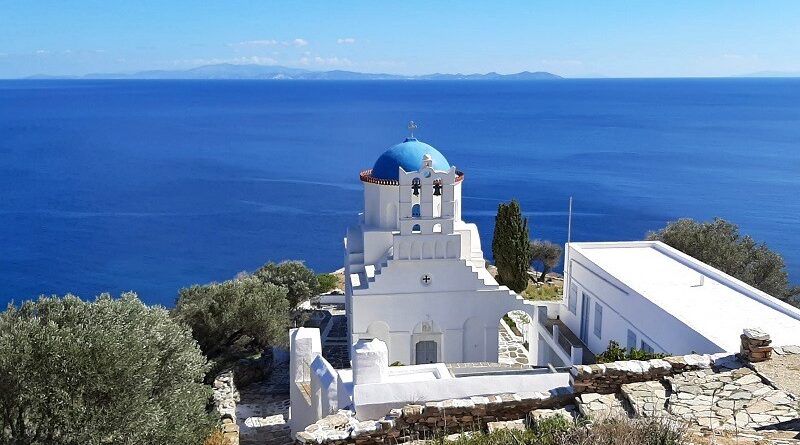Sifnos Travel Guide: Explore the Best Sights and Beaches
This travel guide covers the best sights and beaches you can visit on Sifnos, a stunning Greek island that is part of the Cyclades.
Sifnos travel guide
On my autumn trip to the Cyclades, Sifnos was the first island I visited.
Sifnos proved to be a wonderful travel destination with some excellent beaches, charming towns, stunning views, and a couple of interesting historical sights.
In this guide, I will highlight what I believe are the best sights and beaches to visit on the island of Sifnos, along with a few other points of interest.
In the following chapters of this trip report, you can then read my first-hand account of visiting these Sifnos sights and how I found the experience.
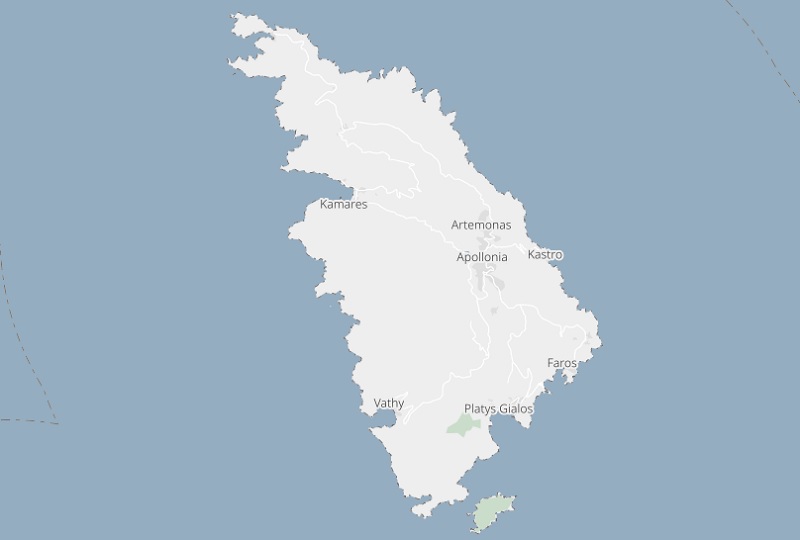
Kamares
If you travel to Sifnos, the small harbour town of Kamares is likely to be your first port of call on the island, as all ferries arrive here.
Kamares is your typical small island port in Greece: It’s bustling with activity when a ferry arrives, but once the ship has departed, life instantly takes on a more sedate form.
There are a few small guest houses and hotels in Kamares, along with several cafés, bars and restaurants, as well as a bakery and a small supermarket.
As the main port of entry to Sifnos, Kamares is also home to most of the car rental companies on the island, and you will find two ATMs in town as well.
Although the town of Kamares itself is not particularly picturesque, it is set in a highly scenic location on a bay, flanked by craggy mountains, allowing you to enjoy some wonderful views from here.
The wide beach surrounding the sheltered bay is one of the nicer ones on Sifnos, featuring shallow water and soft, golden sand.
Only a small part of Kamares Beach closest to the town is organised, and here you can rent sunbeds with umbrellas.
Apart from the small organised section, Kamares Beach retains its wild, natural beauty, and if you wish to put down your own towel, you will find more than enough space on the sand or in the shade beneath the trees lining the beach.

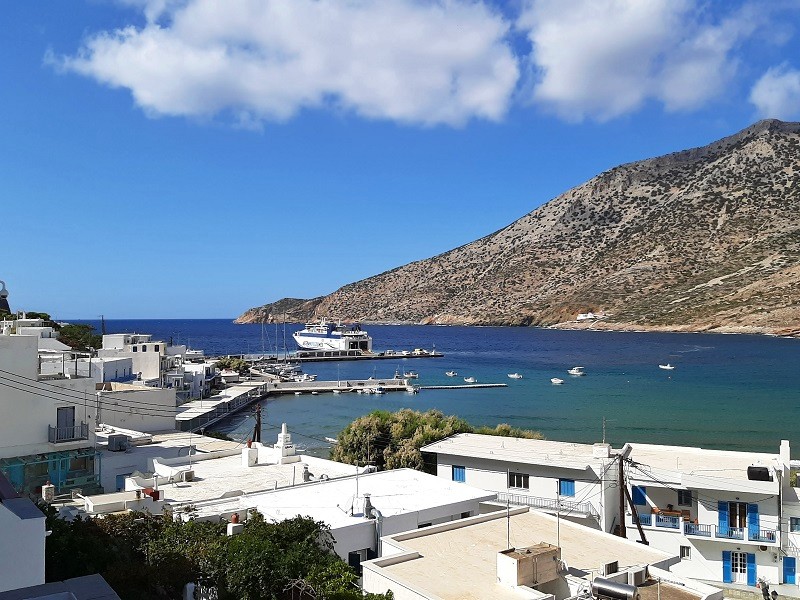
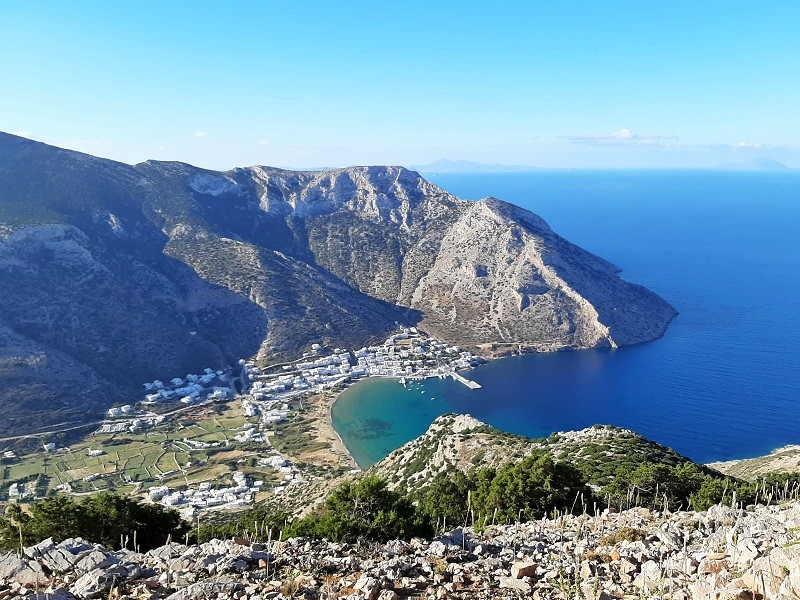
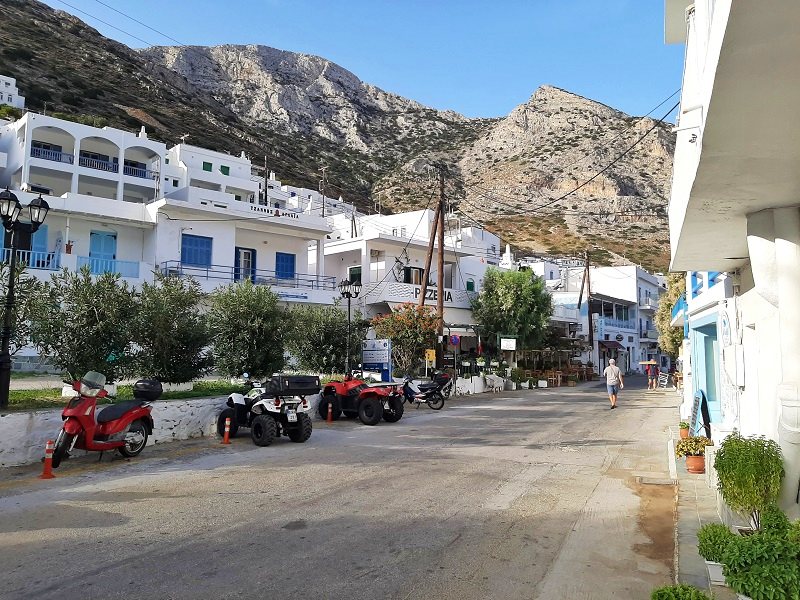
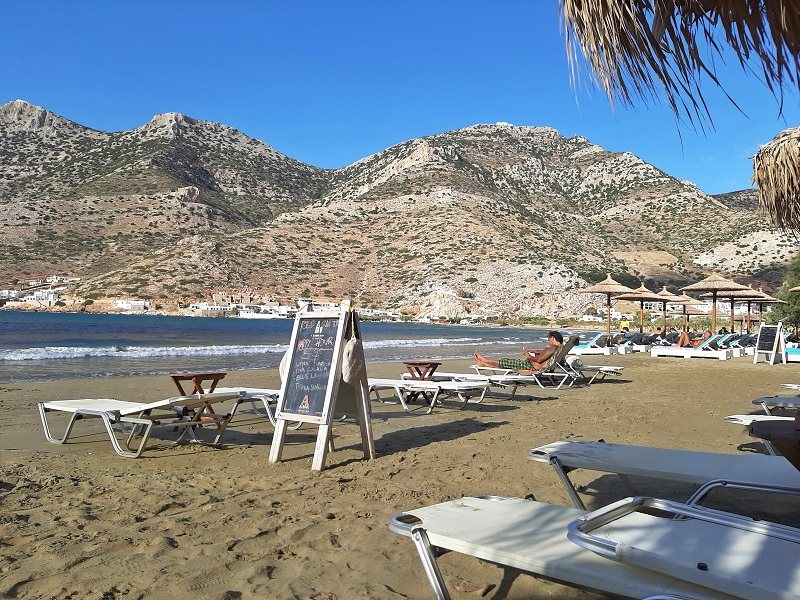
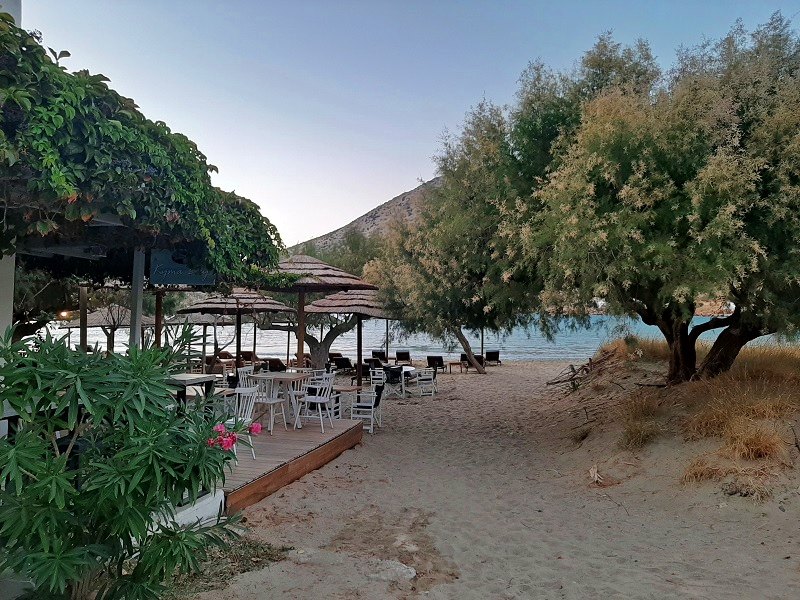
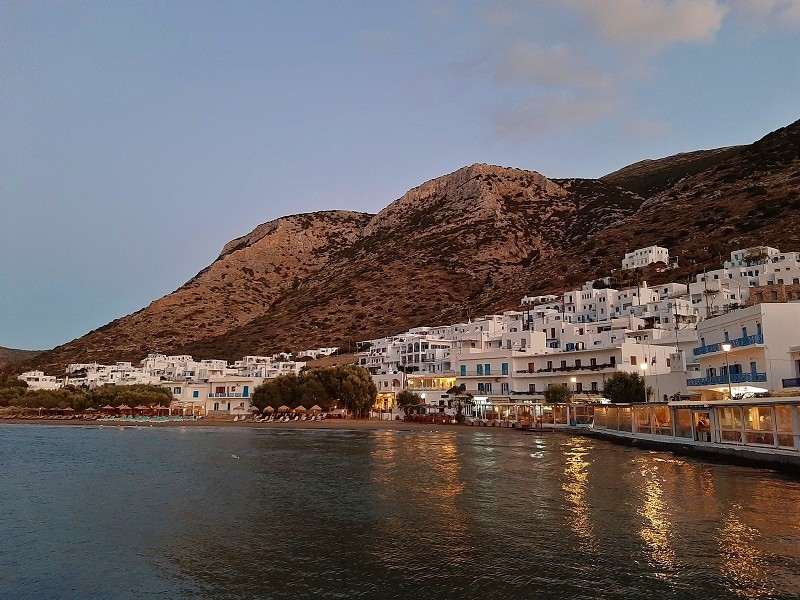
Agios Symeon
If you take the winding mountain road from Kamares to Troulaki and Cherronisos, you will eventually pass the Church of Agios Symeon.
You can either park your car along the main road and walk along a path for 15 minutes to the church, or drive along the paved but rather narrow and steep access road to the church’s doorstep.
The Church of Agios Symeon was built in 1667, although it has been recently renovated.
Although the whitewashed church with its blue dome and large forecourt is certainly pretty, the main reason to visit the Church of Agios Symeon is the wonderful view over the rocky coast of Sifnos and the port of Kamares.
Especially at sunset it’s well-worth driving to Agios Symeon to take in the fantastic view of the sun dipping into the Aegean Sea.
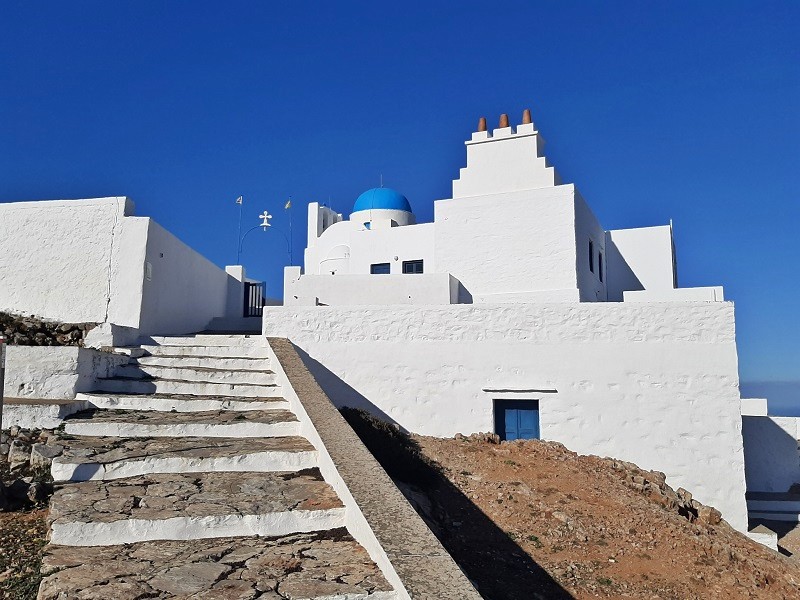
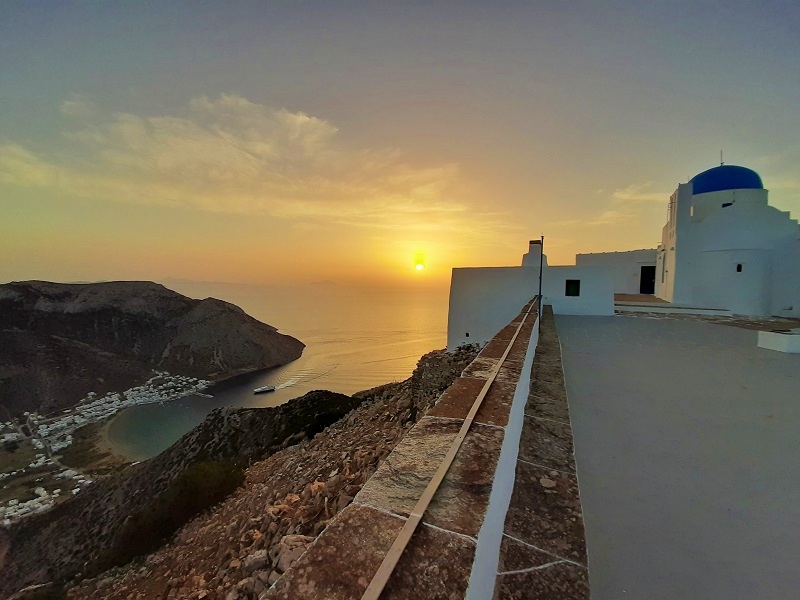
Prophet Ilias of Troulaki Monastery
Just a short distance from the Church of Agios Symeon lies the small Monastery of Prophet Ilias of Troulaki, which also boasts a stunning location atop a mountain with sweeping views over Sifnos and the Aegean Sea.
If you want to reach the monastery, you will need to leave your car by the main road, from where it’s a 20-minute uphill walk via some steps and a sand and stone path.
The Monastery of Prophet Ilias of Troulaki should not be confused with the much more interesting Monastery of Profitis Ilias of Psilos, which is situated on the island’s highest mountain and is one of the main religious sights of Sifnos.

Vroulidia Beach
Just north of the unremarkable village of Troulaki, a side road leads down the cliffs to Vroulidia Beach (Paralia Vroulidia).
The access road to Vroulidia Beach is narrow and extremely rough, although I heard after my trip to Sifnos that the road is in the process of being paved, so if you visit it now, you are likely to find a much better road than I encountered!
Vroulidia is a pebble beach located at the end of a sheltered bay between high slopes, and it features a tavern.
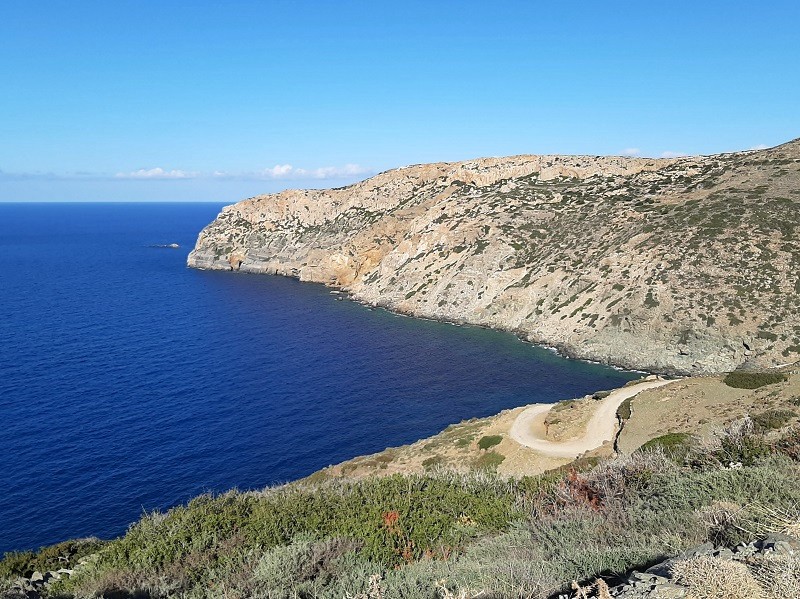
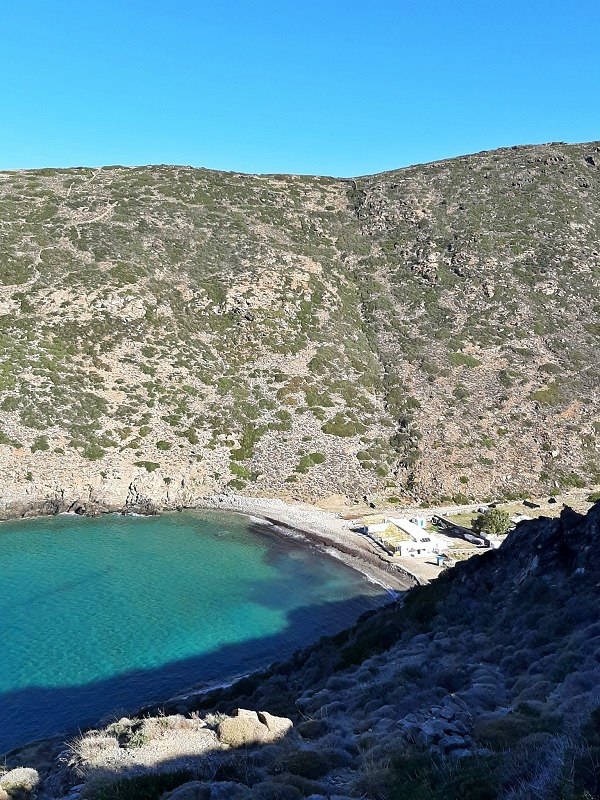
Cherronisos
Cherronisos, the northernmost village on the island of Sifnos, is a picturesque settlement situated around a rocky, sheltered bay with beautiful blue waters.
In Cherronisos (sometimes also spelled as Cheronissos), you’ll find a couple of taverns overlooking the sea, making them inviting spots for lunch or a drink, and surely some of the most picturesque on Sifnos.
There is also a small sandy beach in Cherronisos, although I preferred to jump into the sea from one of the rock-and-concrete swimming platforms with swimming stairs along the shoreline of this quaint fishing village.

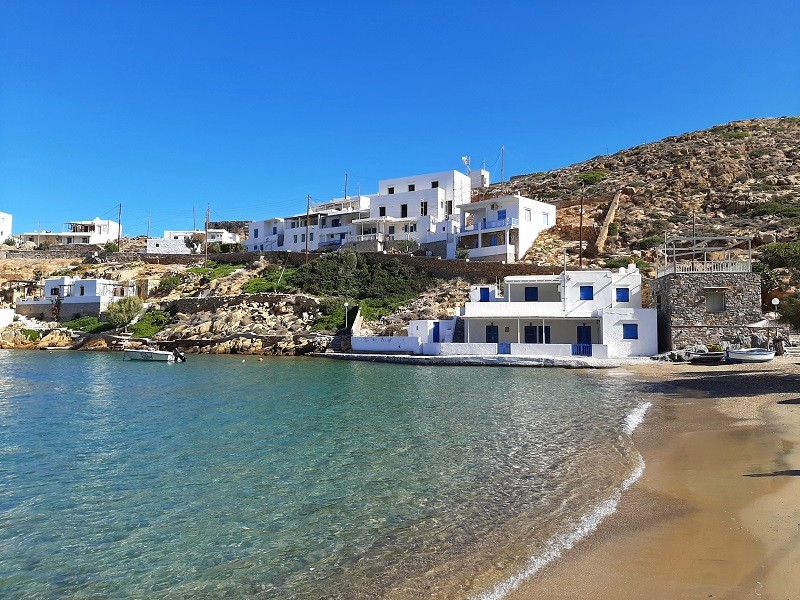
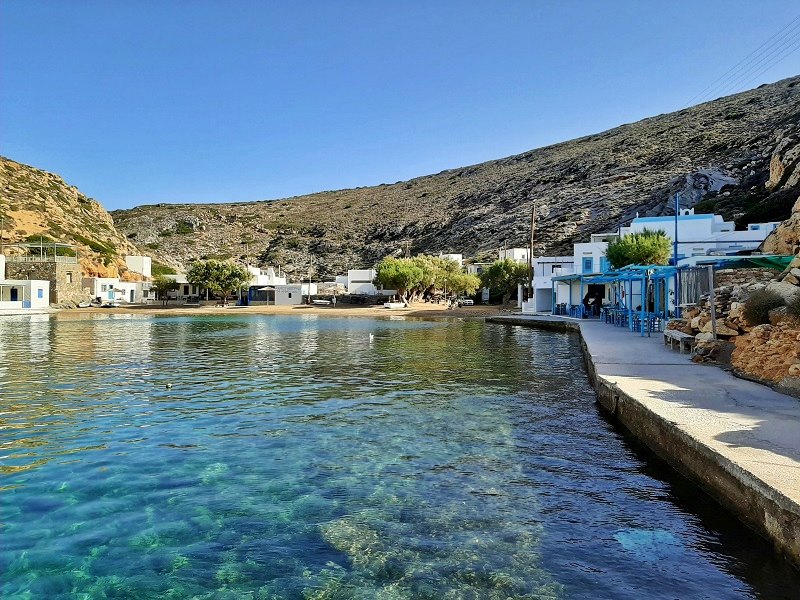
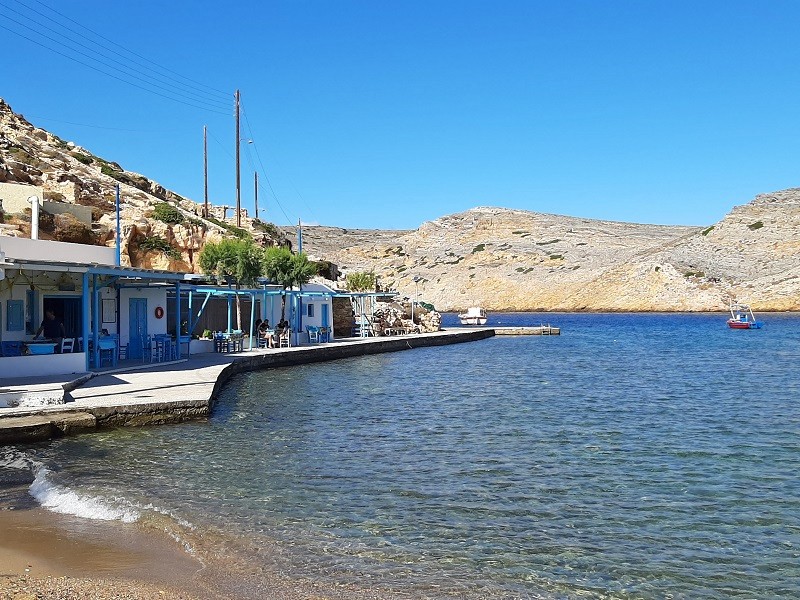
Agios Georgios
Immediately north of Cherronisos lies the small monastery and church of Agios Georgios.
You can park your car at the gate and walk the last few metres uphill along the gravel path to the monastery.
Make sure to close the gate behind you, as it was built to prevent the goats from escaping the premises!
Much of the beauty of the Monastery of Agios Georgios lies in its wild location on the windswept, barren peninsula that forms the northern tip of Sifnos.
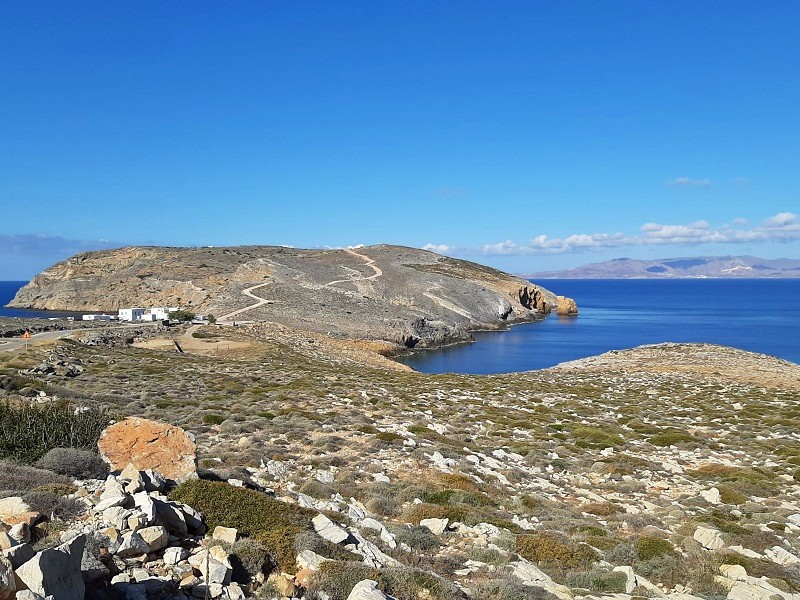
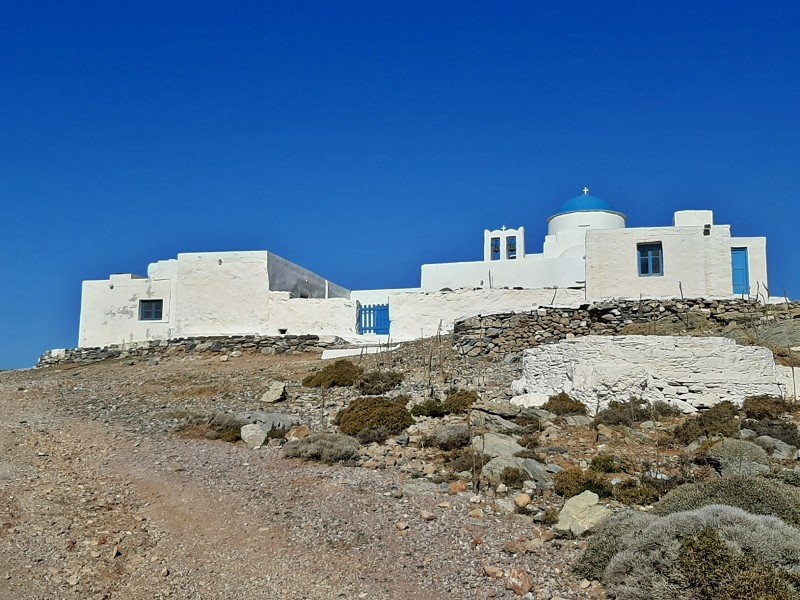
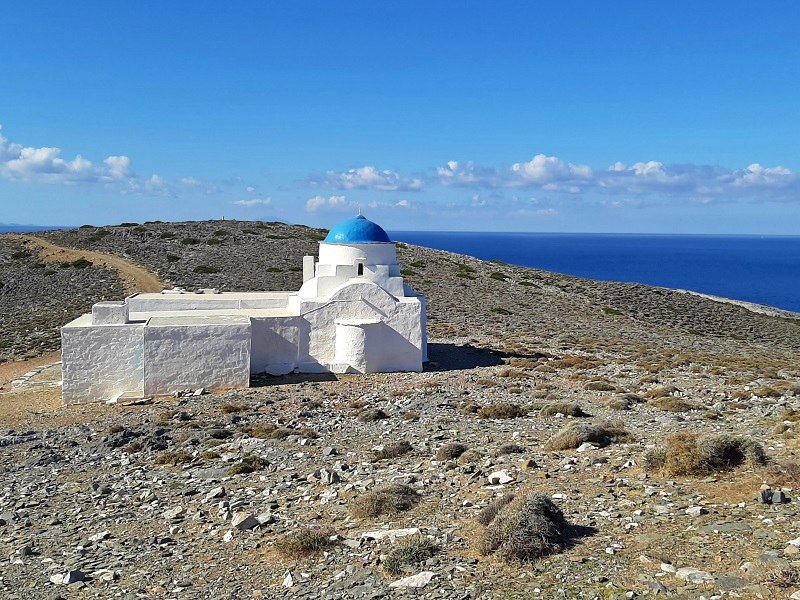
Apollonia
Apollonia is the largest town on Sifnos and serves as the commercial hub of the island
Situated on a hill in the centre of the island, Apollonia essentially forms one conglomeration with the town of Artemonas to its north.
In Apollonia, you can find facilities such as banks, bakeries, shops, cafés, and taverns, along with a number of hotels, as well as studios and apartments for rent.
You can also find several grocery stores in Apollonia, including the Kritikos in the adjoining settlement of Kato Petali, which is the largest supermarket on the island of Sifnos.
When driving on the main road through Apollonia, the town may not appear particularly appealing, but this is merely a deception, as its charms are hidden in the backstreets, which can only be discovered on foot.
Park your car somewhere in town and explore the picturesque backstreet alleys of Apollonia, with their many steps and sweeping views over the surrounding countryside.
It’s on these narrow streets that you can truly appreciate the beauty of Apollonia, feel its typical Cycladic charms, and admire the old whitewashed houses and ornate churches of the town.
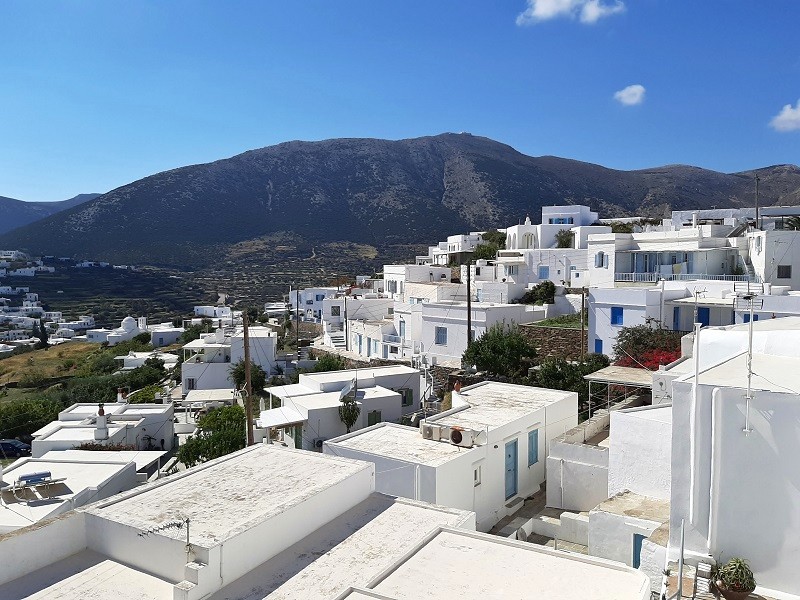

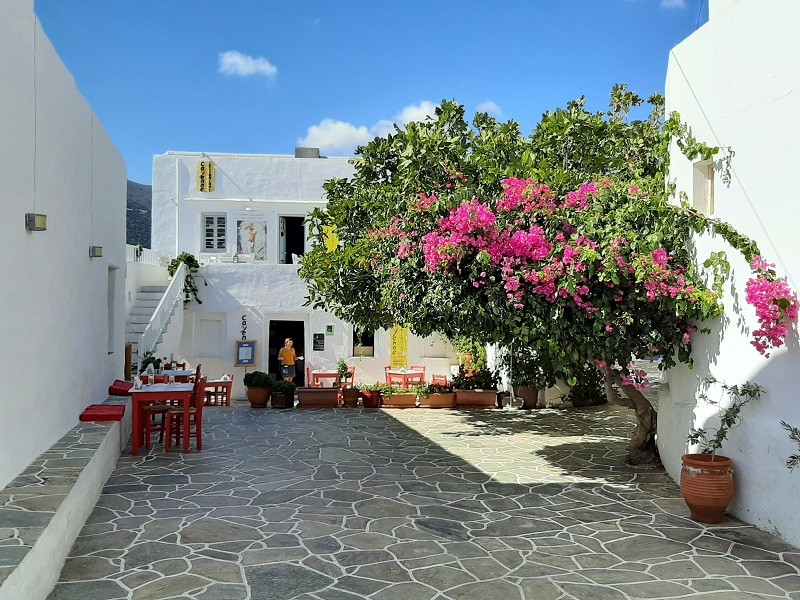
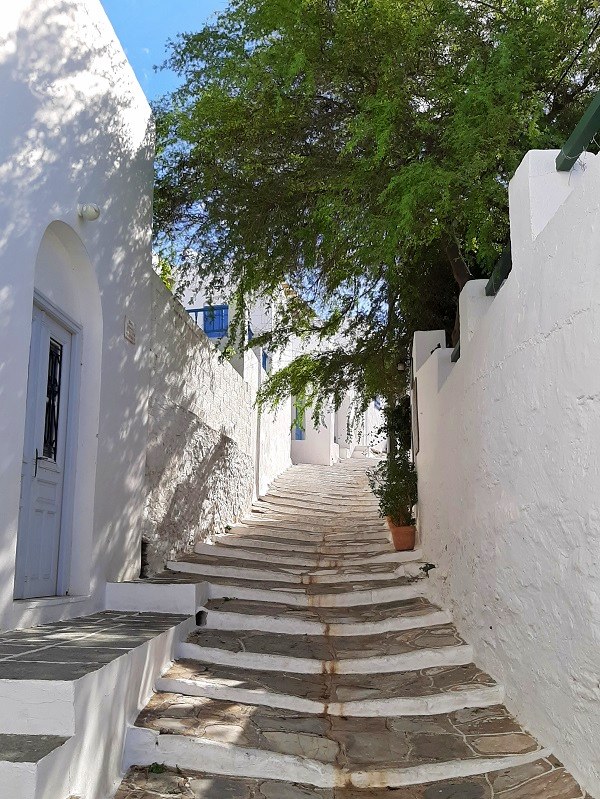
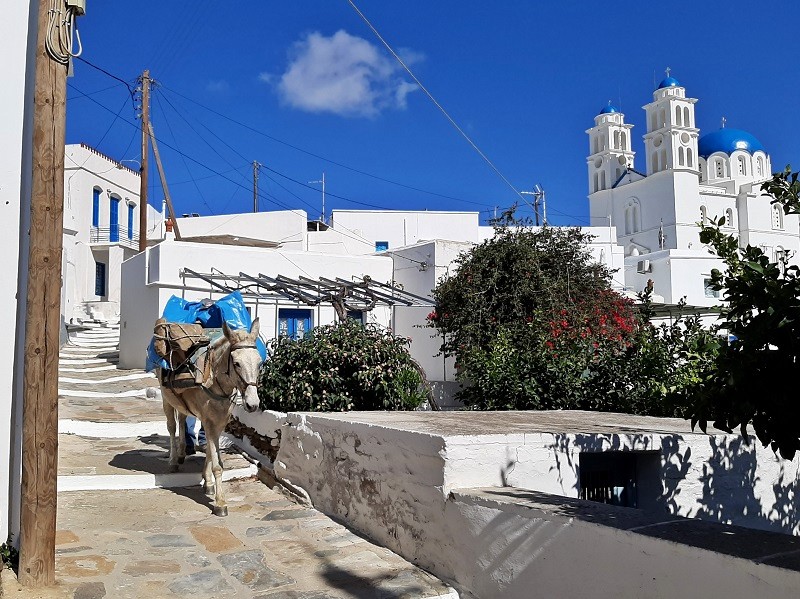
Panagia Poulati
One of my favourite sights on Sifnos is the Church of Panagia Poulati, which surely ranks as one of the most picturesque in all of the Cyclades.
A narrow gravel road winds down the mountain from Artemonas to the Church of Panagia Poulati.
Although the Church of Panagia Poulati is beautiful to see up close, it is an even more spectacular sight from a higher vantage point.
From an elevated viewpoint, this whitewashed church with its blue dome contrasts perfectly with the deep blue Aegean Sea in the background.
It is also well worth walking further down from the Church of Panagia Poulati to the sea, as you will find an appealing swimming spot there, although the sea can be rough here when strong meltemi winds blow from the north.
There are a couple of other picturesque churches on the craggy and wild northeastern coast of Sifnos, particularly the Church of Agios Sostis, although reaching this church will require a bit of a longer walk from its trailhead along the main road.


Kastro
Overlooking the sea on the eastern coast of Sifnos lies the hilltop town of Kastro, which is one of the most beautiful and interesting sights to visit on the island.
Kastro has been inhabited since prehistoric times and served as the capital of Sifnos for many centuries until the inland town of Apollonia took over this title in 1836.
Kastro was already an important settlement in ancient Greek times, when the town featured an important theatre and a temple dedicated to Dionysos, and the remains of its 6th-century BC acropolis can still be seen today.
However, it was the Venetians who left the most lasting legacy, as their medieval fortifications and urban planning form the foundation of the current town of Kastro.
Kastro means “castle” in Greek, but in the case of Sifnos, it does not refer to an actual castle like those typically found in western European countries such as France or Germany, but rather to a fortified town.
Indeed, Kastro was not fortified by placing traditional walls and keeps around the town, but by the manner in which its streets and houses were built.
The streets and houses of Kastro were built in a circular layout around the hill, forming two defensive rings, with the stone houses doubling as walls.
Six gateways were integrated into houses at strategic points to guard the entry to the next line of defence.
To visit Kastro, simply leave your car at one of the parking lots at the foot of the hilltop town and follow the circular streets uphill.
Kastro has a couple of accommodation units, mostly in the form of rooms and apartments for rent, although the number of bars and restaurants in town can be counted on one hand.
With just over 100 residents today, down from around 5,000 in the 17th century, Kastro certainly isn’t the liveliest place on the island and can even feel a bit like a living open-air museum, but it’s still a must-visit sight if you travel to Sifnos.
Simply put, it’s a pure delight to explore the winding streets of Kastro, and the higher you climb, the more picturesque this quintessentially Cycladic town with its whitewashed houses and scenic viewpoints becomes.
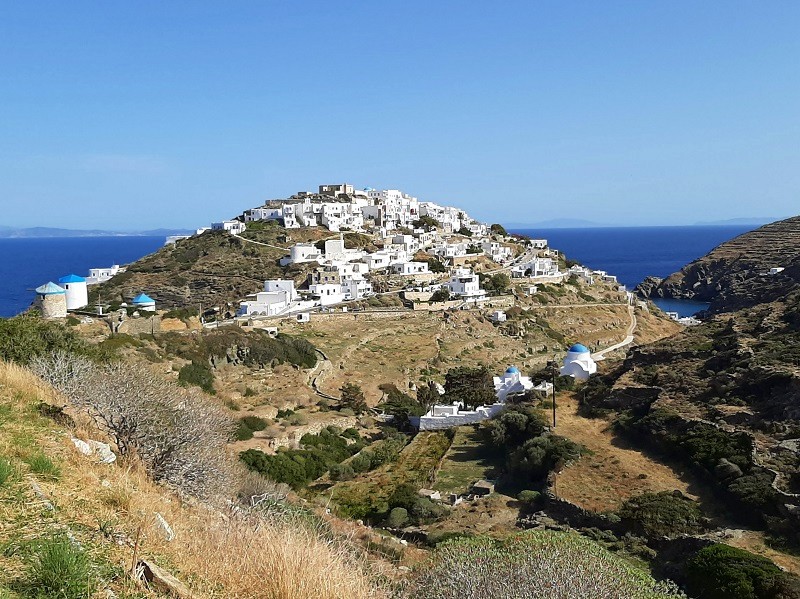
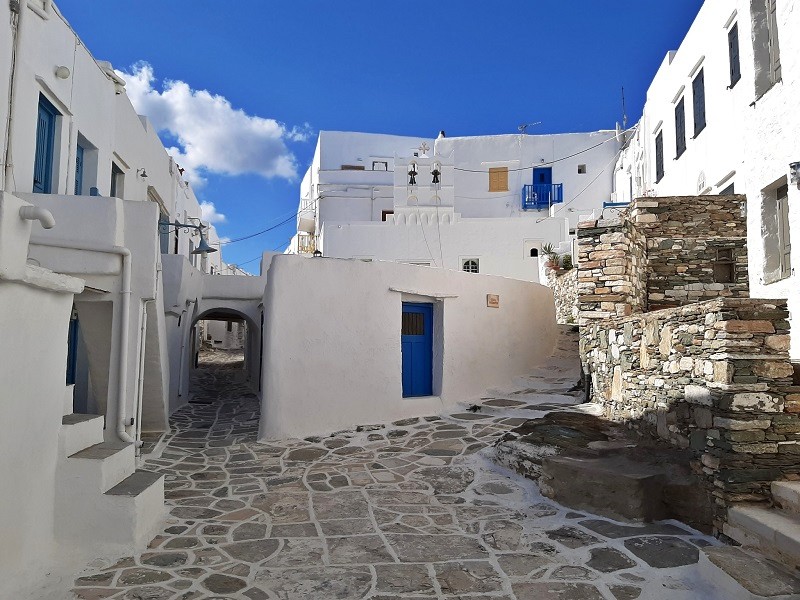
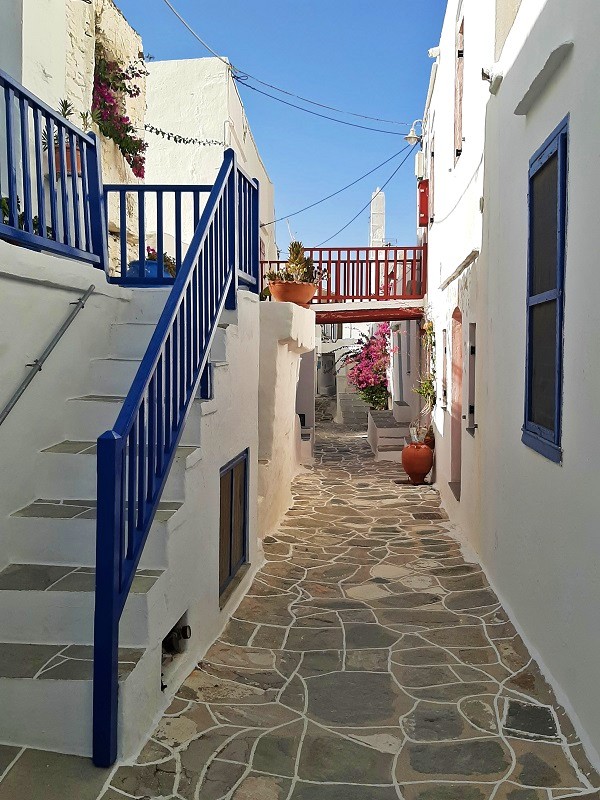
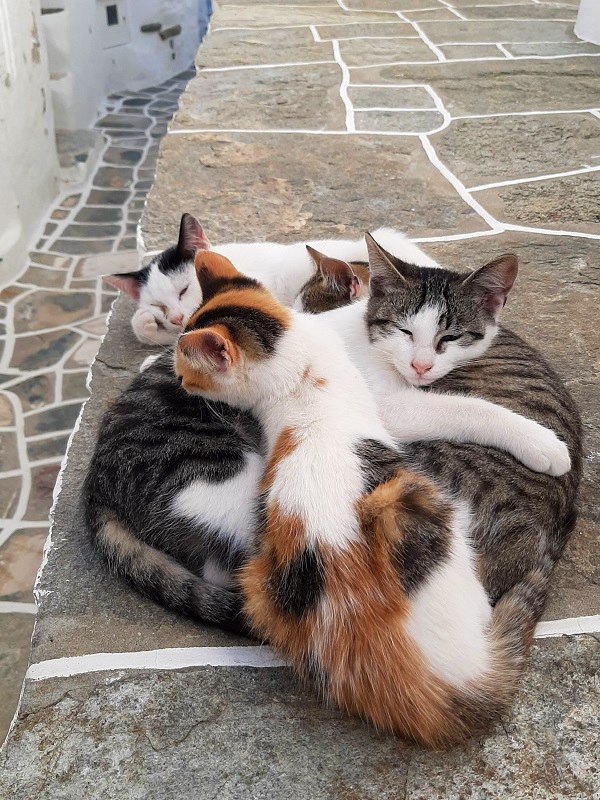
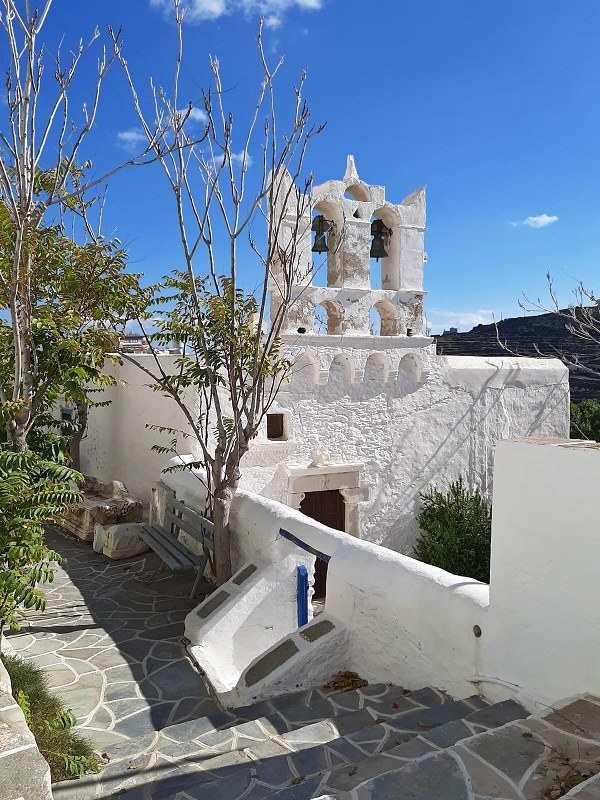
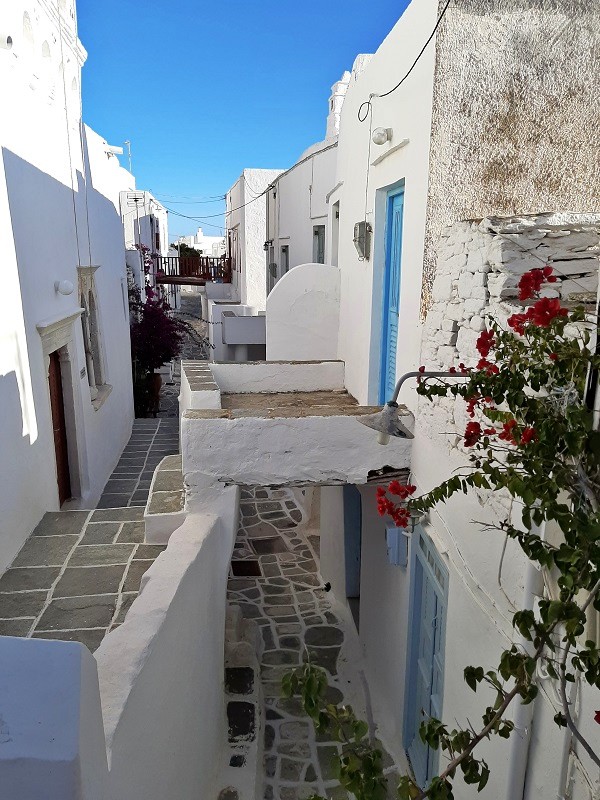
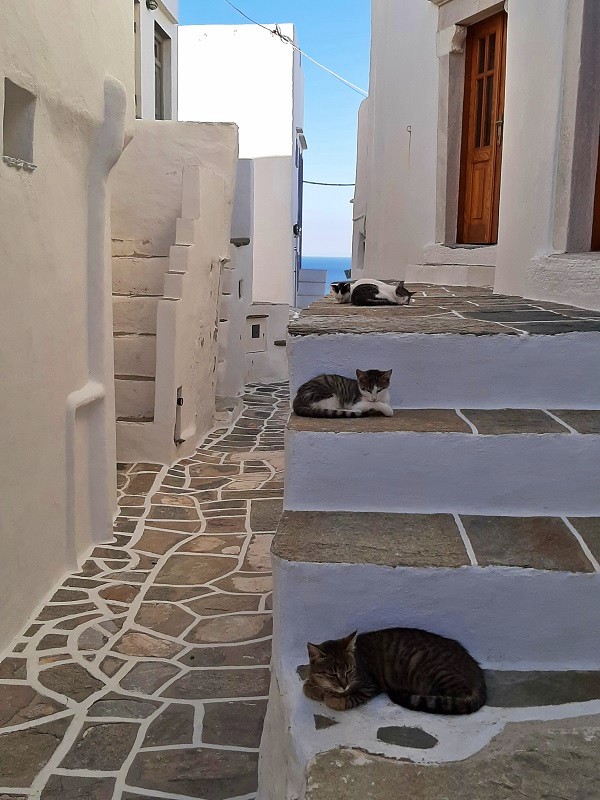
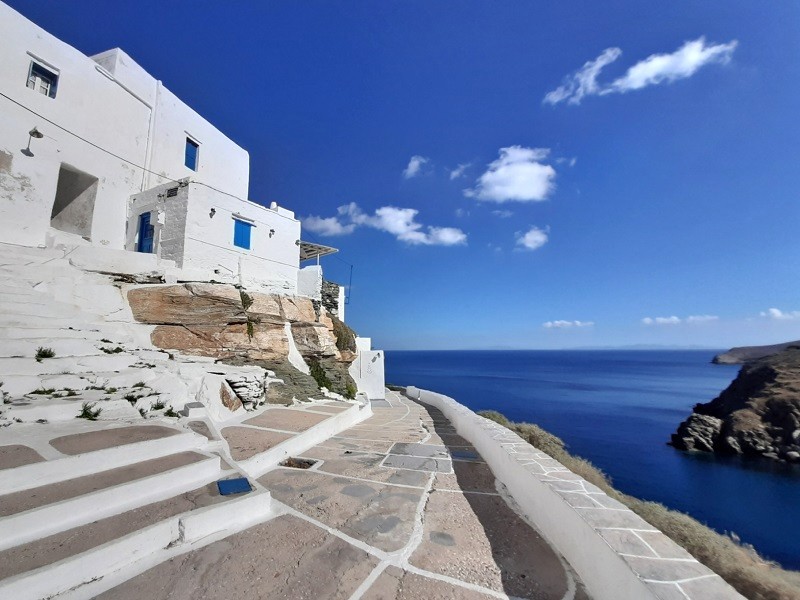
Church of the Seven Martyrs
One of the best-known sights on Sifnos, the Church of the Seven Martyrs, is just a short walk from Kastro.
If you have seen images of Sifnos before, chances are that at least one featured this picturesque church perched on a rocky promontory.
From Kastro, a path with over 200 steps winds down the rocks to the Church of the Seven Martyrs, which has a typical Cycladic design with white walls and a blue dome.
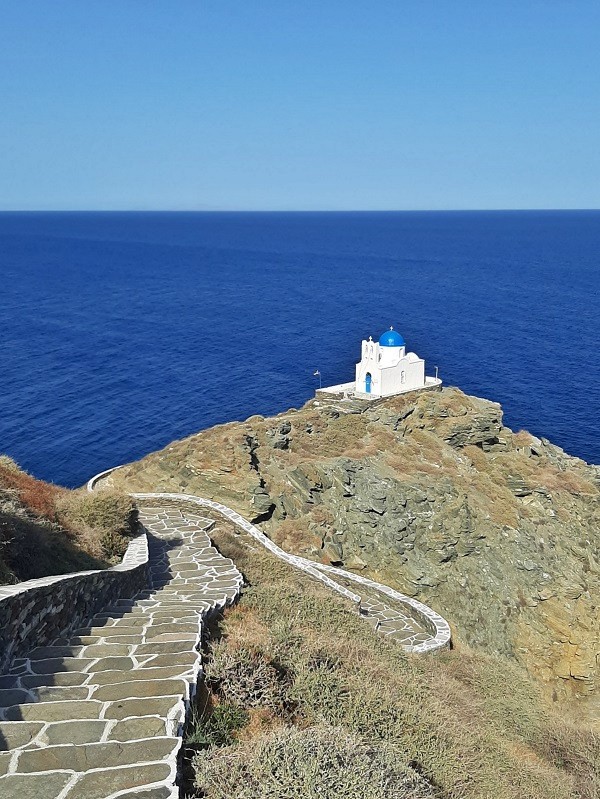
Seralia Beach
Another interesting place to visit is Seralia, a small fishing settlement and beach situated at the foot of the hilltop town of Kastro.
Although pebbly Seralia Beach (Paralia Seralia) may not rank among the best beaches on Sifnos, it is a scenic spot to soak up the local atmosphere.
I certainly enjoyed sitting for a while on the concrete platform overlooking the rocky shore, watching some fishermen bring in their catch.

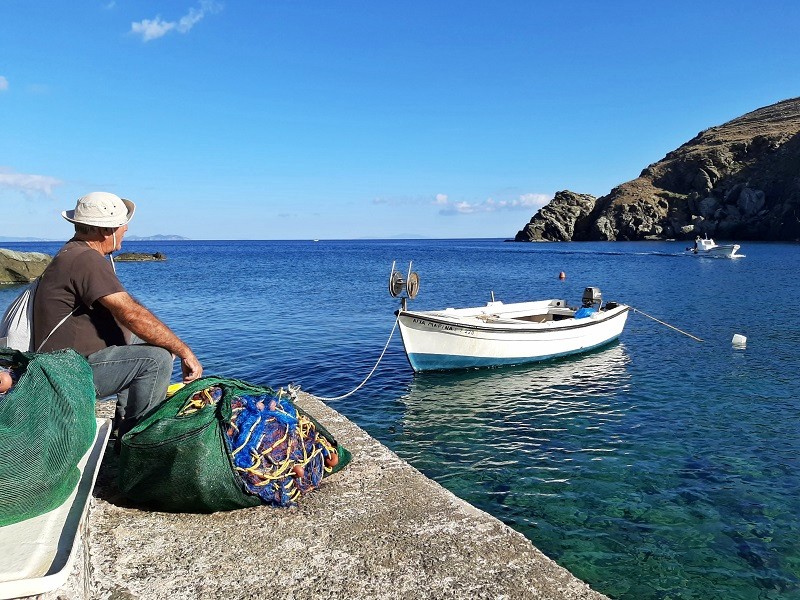
Mycenaean Acropolis of Agios Andreas
The Mycenaean Acropolis of Agios Andreas is an intriguing archaeological site located on a hilltop in the heart of the island of Sifnos.
In the 13th century BC, the Mycenaeans used this site to build an acropolis, which refers to a fortified part of an ancient Greek city usually located on a hill that served as a natural defensive point.
Even after the collapse of the Mycenaean civilisation, this hilltop citadel remained inhabited and reached its peak during the Archaic Period around the 7th century BC, after which it fell into a slow but steady decline.
The fortifications, consisting of an inner and outer defensive wall, along with the foundations of houses and narrow streets laid out in a grid-like pattern, can still be clearly identified.
The archaeological site also features a small museum that is well worth a visit.
Next to the archaeological remains of the ancient acropolis, you can admire the 17th-century Church of Saint Andrew, which features a fine Cycladic design and offers sweeping views from its courtyard over the eastern coast of Sifnos and the distant islands of Antiparos and Paros across the sea.
You can either leave your car along the main road from Apollonia to Vathi and climb up the hill to the Acropolis of Agios Andreas via a strenuous but beautiful path, or take the paved side road around the hill until you reach the museum parking lot from the back.
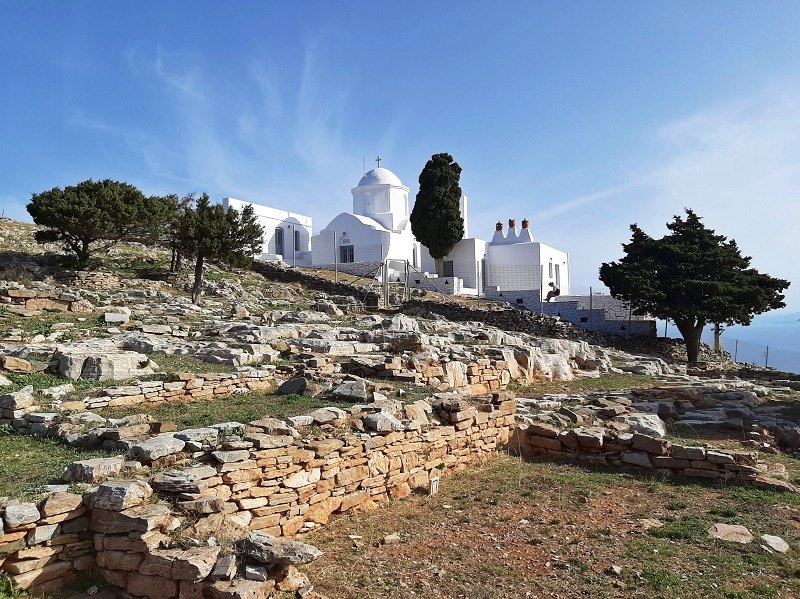
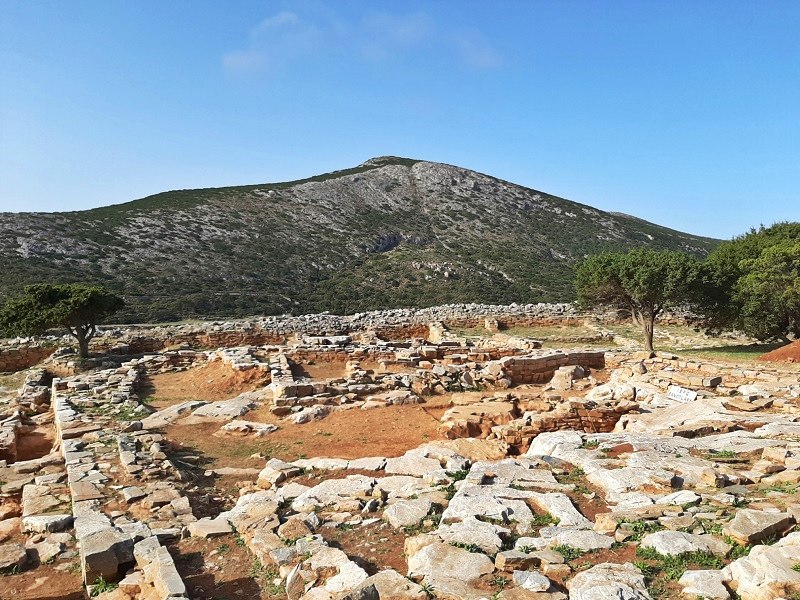
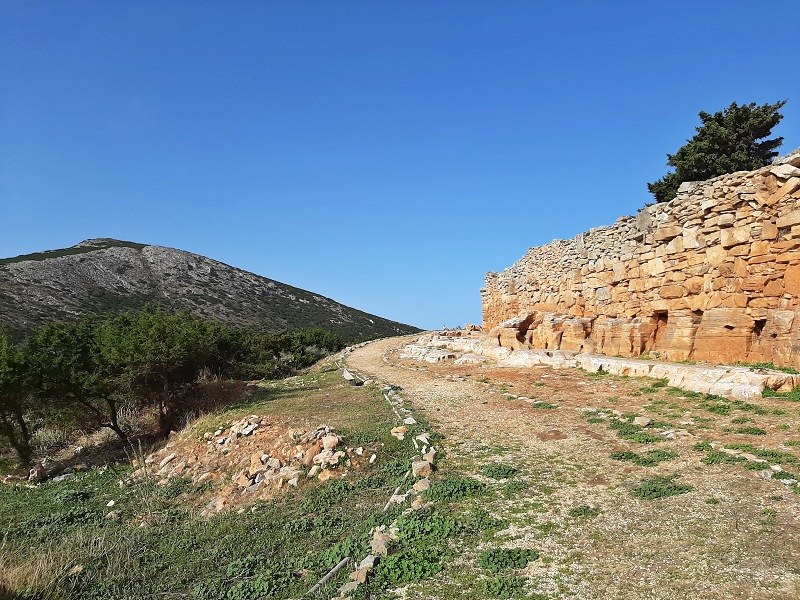
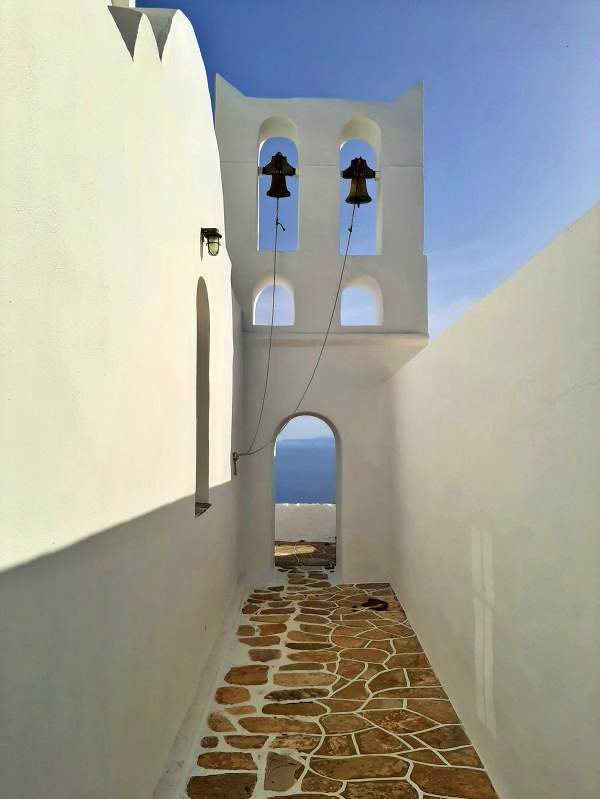
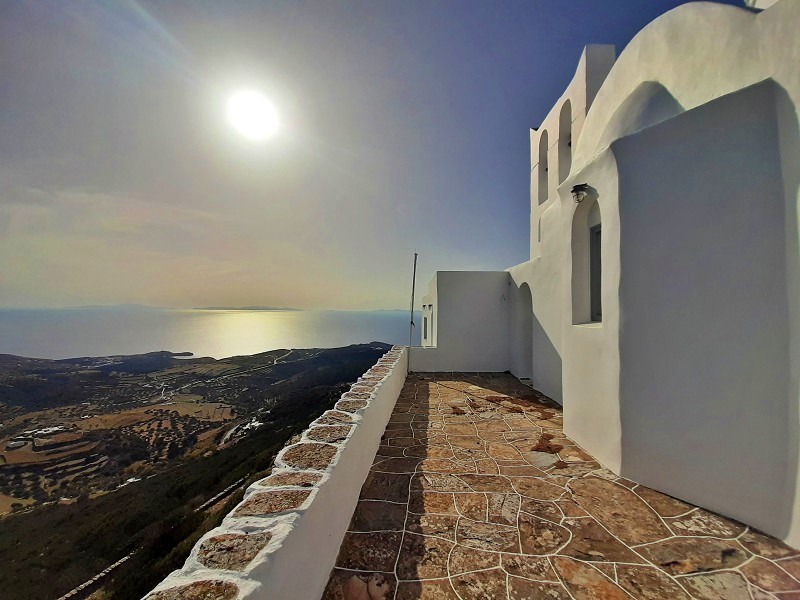
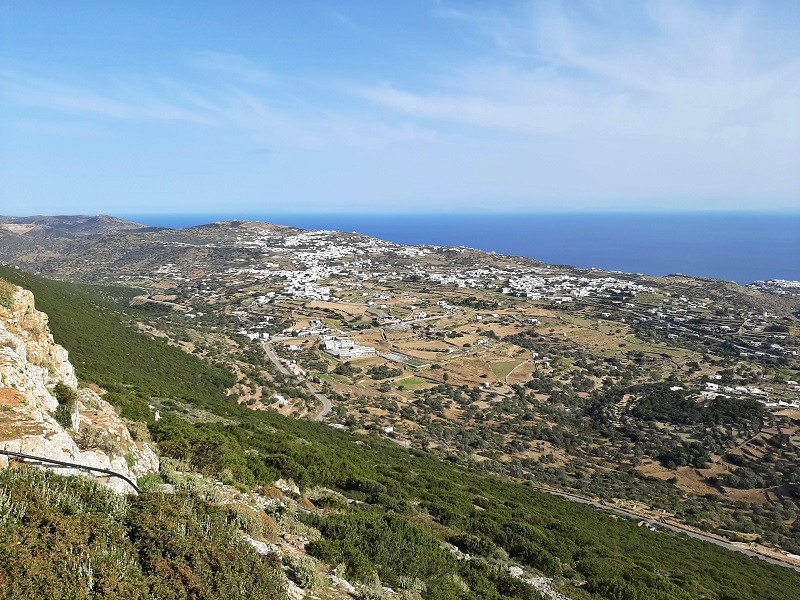
Vathi
Nestled along a sheltered bay, Vathi, alternatively spelled Vathy, is one of the main seaside towns on the island of Sifnos.
With its fine sands, Vathi Beach undoubtedly ranks among the best beaches on the island of Sifnos.
A section of the beach offers sunbeds and umbrellas for rent, along with a beach bar.
Although Vathi is not a large town, it offers a surprisingly wide range of accommodation options, including a luxury resort as well as simple rooms and apartments for rent.
The town features a picturesque church situated right by the sea, overlooking the jetty.
There are a couple of appealing seaside tavernas in Vathi, some of which have tables right on the beach.
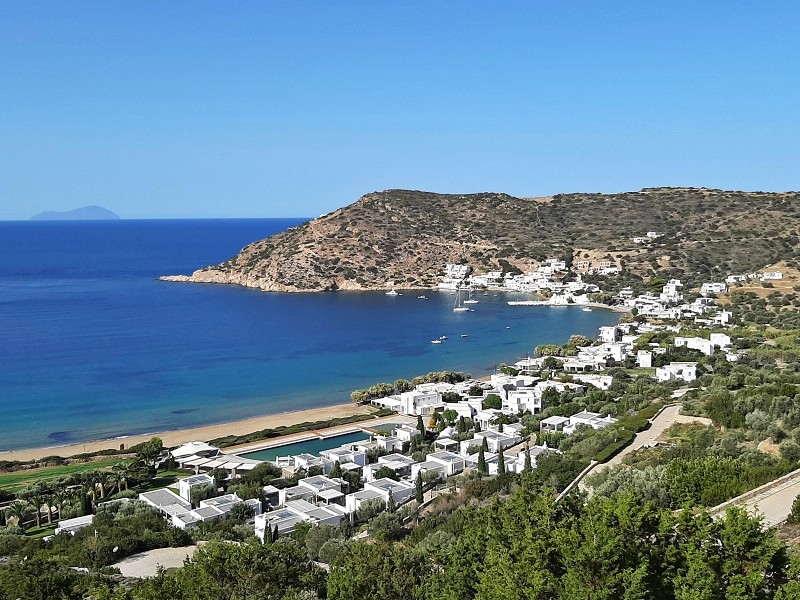
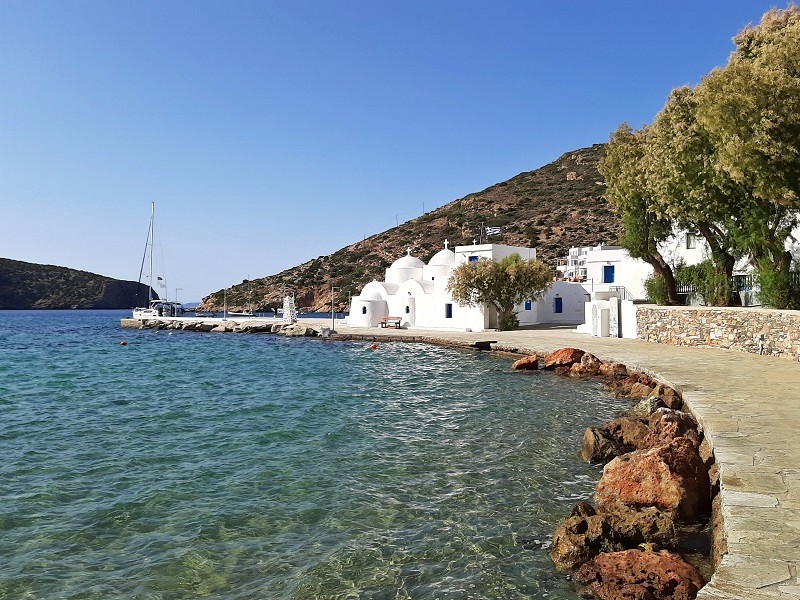
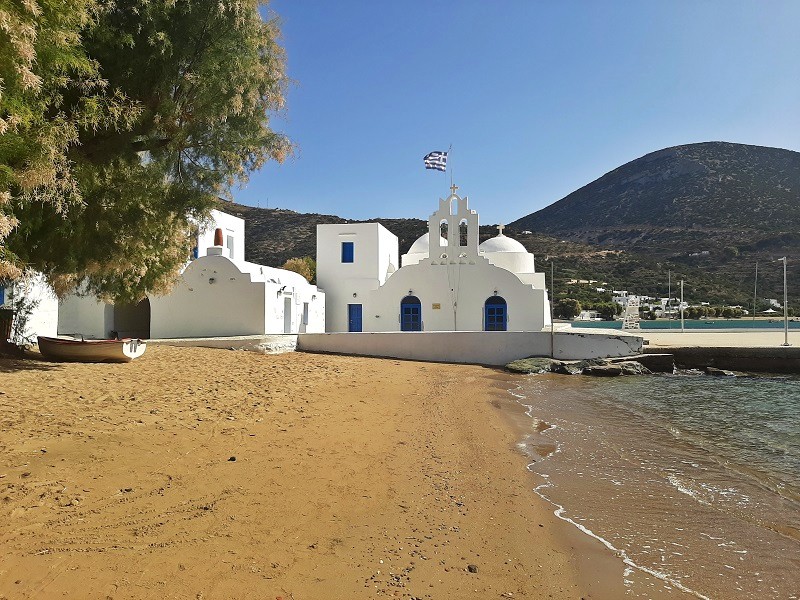
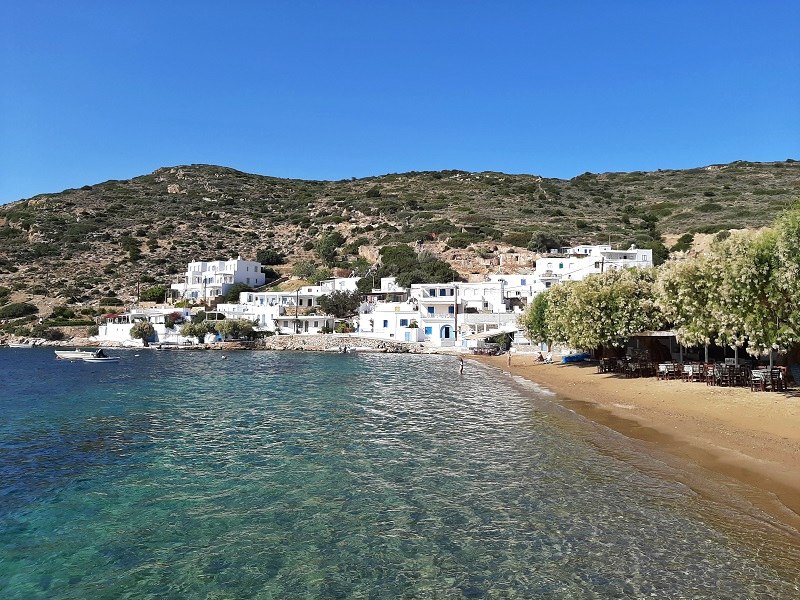
Platis Gialos
Another pleasant seaside town on the southern coast of Sifnos is Platis Gialos.
Like Vathi, Platis Gialos is nestled around a tranquil bay and boasts a beautiful sandy beach, ideally suited for families with children due to its shallow waters.
Although Platis Gialos has a beautiful setting when viewed from the access road high up the hill, the town itself isn’t particularly picturesque, and there are no real points of interest aside from its beach.
However, there are a couple of appealing bars, cafés and tavernas in Platis Gialos, and you will also find a decent range of hotels in town.
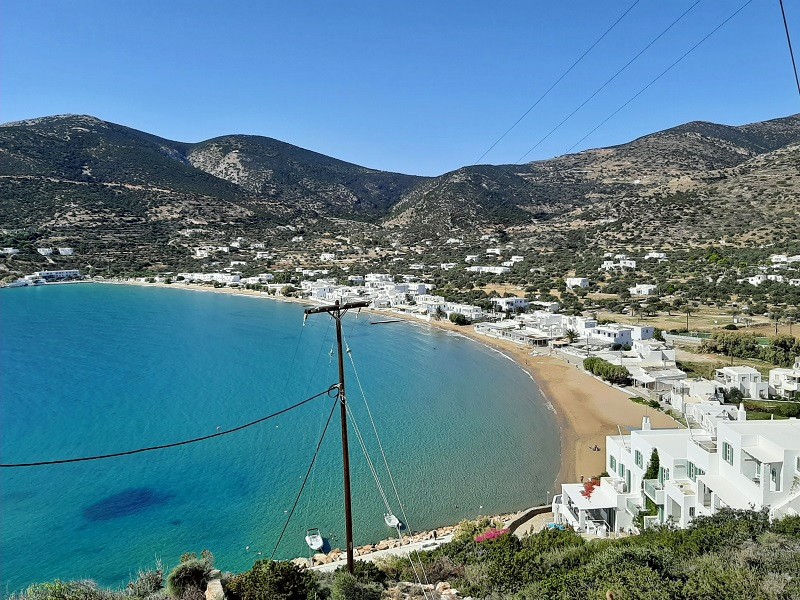
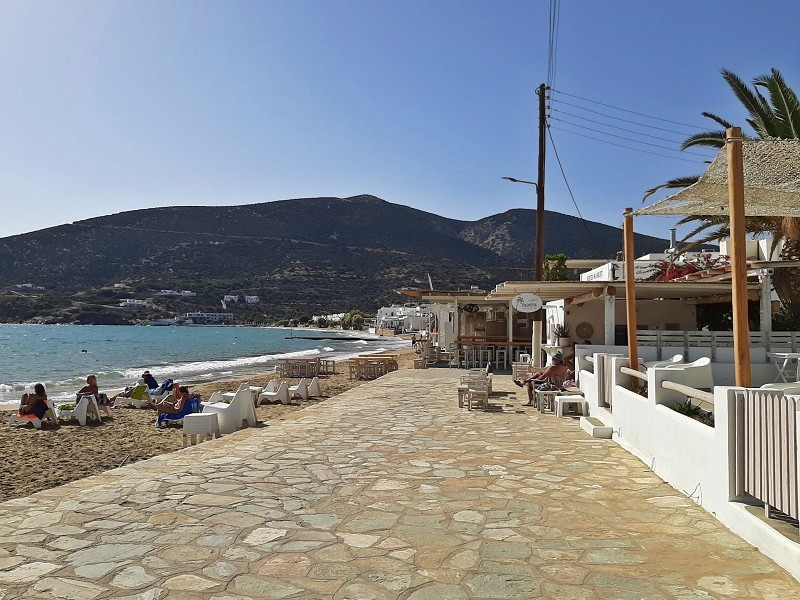
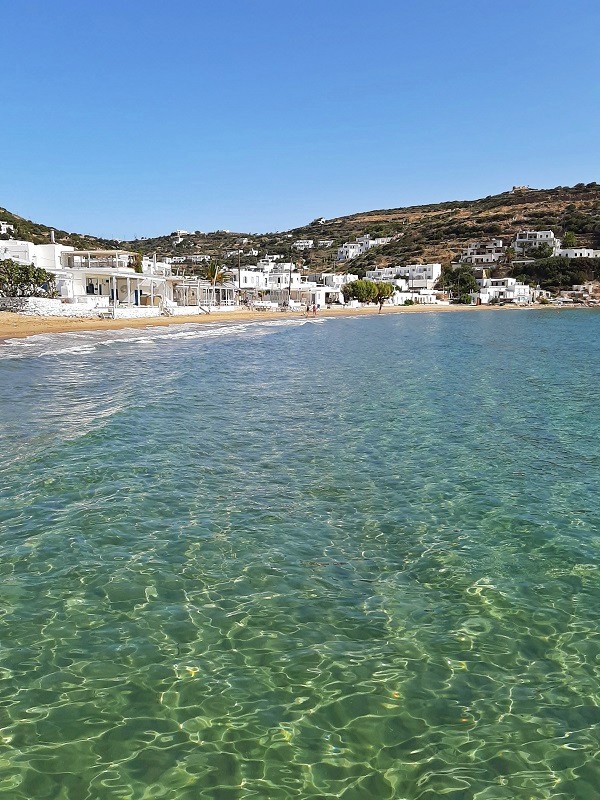
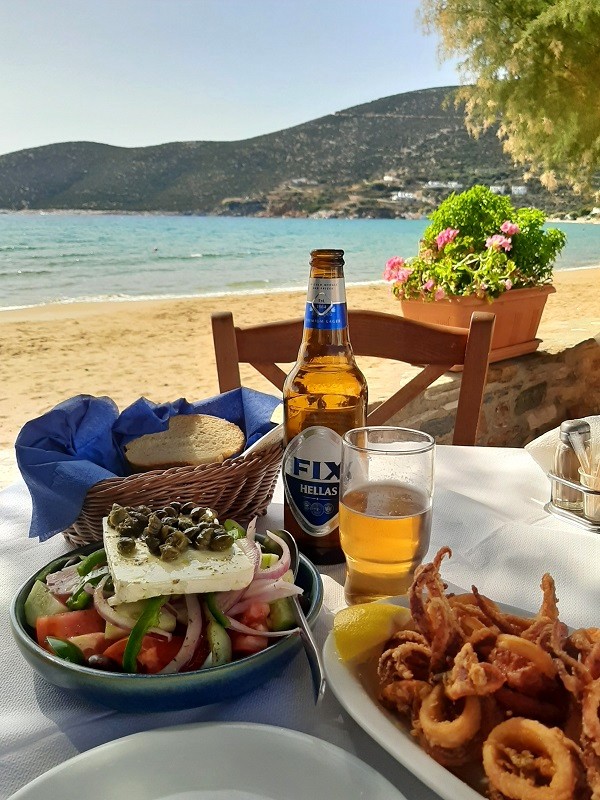
Chrysopigi Monastery
Situated on the southern coast of Sifnos, approximately halfway between Platis Gialos and Faros, lies the Monastery of the Virgin Mary of Chrysopigi.
This monastery, built in the 17th century, boasts a scenic setting on a rocky promontory that juts out into the sea.
The Virgin Mary of Chrysopigi is the patron saint of Sifnos, and each year on the eve of the Ascension, the Holy Icon of Chrysopigi is paraded across the island in a religious procession.

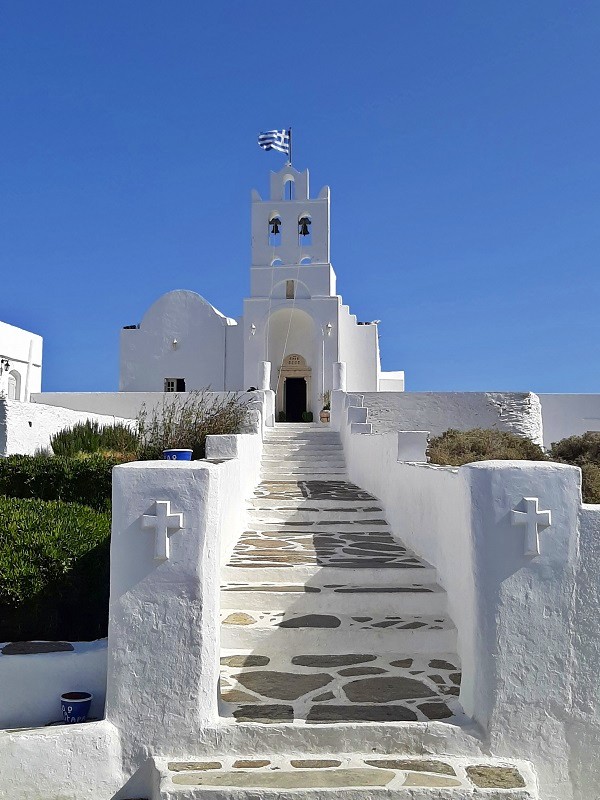
Faros
The small settlement of Faros is a more remote destination on the southern coast of Sifnos, featuring a couple of secluded beaches, two restaurants, and a range of both low-key and luxury accommodation options.
Monastery of Profitis Ilias of Psilos
The imposing Monastery of Profitis Ilias of Psilos is located at the top of Profitis Ilias Mountain, which at an altitude of 682 metres above sea level is the highest point on the island of Sifnos.
From the Firogia trailhead along the main road just south of Apollonia, it is a strenuous 3.5-kilometre uphill hike along a rugged mountain path to the Monastery of Profitis Ilias of Psilos.
Alternatively, a rough gravel road leads to a point about 1 kilometre south of the monastery, although you would still need to walk the final stretch.
Getting to Sifnos
Kamares is the arrival port for all ferries, whether you are arriving directly from Piraeus or travelling from one of the other islands along the Western Cyclades ferry route.
Given that Sifnos has no airport, the only other way to arrive on the island is by your own yacht, in which case you can also anchor at some of the other coastal towns.
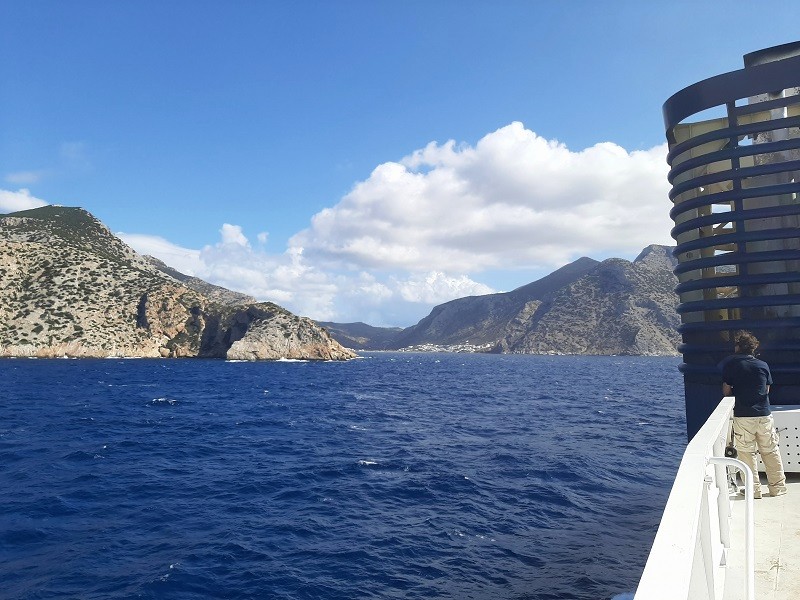
Getting around Sifnos
Sifnos has a public bus service that connects the central towns of Apollonia and Artemonas to various coastal villages and towns, including Kamares, Cheronissos, Kastro, Vathi, Platis Gialos, and Faros.
However, the bus schedule can be limited, with some of the smaller destinations having only four daily departures, and potentially even fewer outside the summer season.
It is therefore best to rent a car when visiting Sifnos, as this provides full flexibility to explore the island’s sights and beaches, including the more remote locations that cannot be accessed by bus.
On my trip to Sifnos, I rented a car from Suntrail in Kamares, a company I can highly recommend.
Taxis are available in both Apollonia and Kamares that will bring you to any destination on Sifnos.
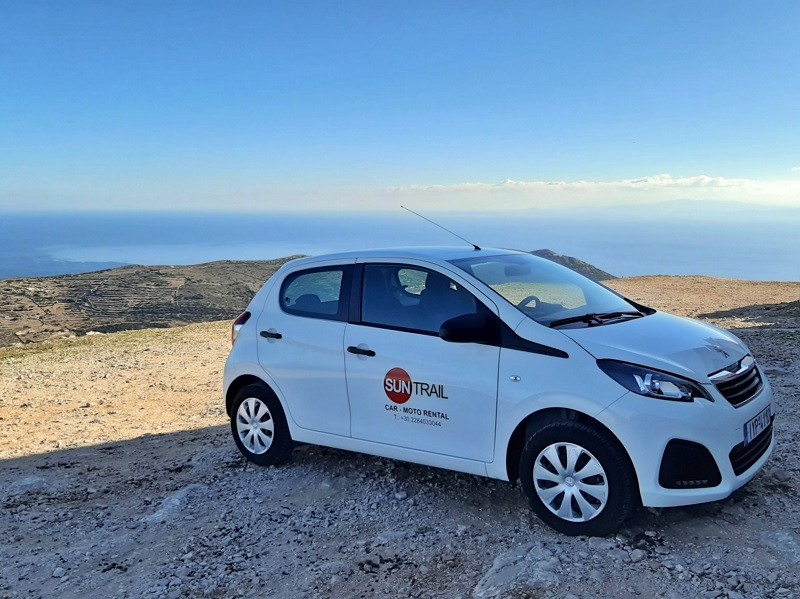
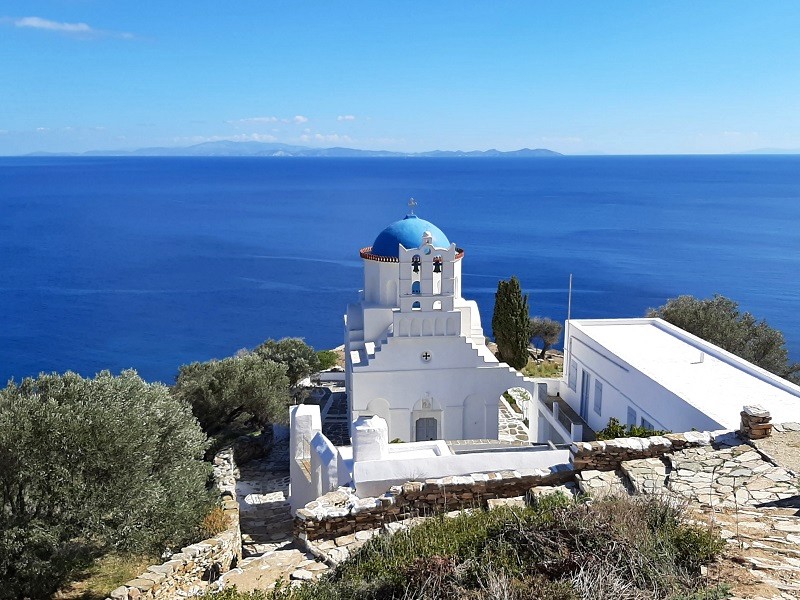
Where to stay in Sifnos
Sifnos offers a wide variety of accommodation options, particularly if you are seeking a simple hotel room or apartment to rent.
More upscale options include villas available for rent, as well as some small-scale luxury resorts on the island.
As one of the less touristy islands in the Cyclades, Sifnos is free from chain hotels, large resorts, and other flashy accommodation options, so if you are looking for such places to stay, you will be better off visiting Mykonos or Santorini instead.
Most tourists visiting Sifnos stay in or around the island’s largest town, Apollonia, or in the seaside towns of Kamares, Vathi, or Platis Gialos, as these locations offer the widest range of facilities and a variety of cafés and restaurants.
I stayed at Simeon Rooms & Apartments in Kamares, where I had a simple but clean double room with a lovely balcony with sea view.
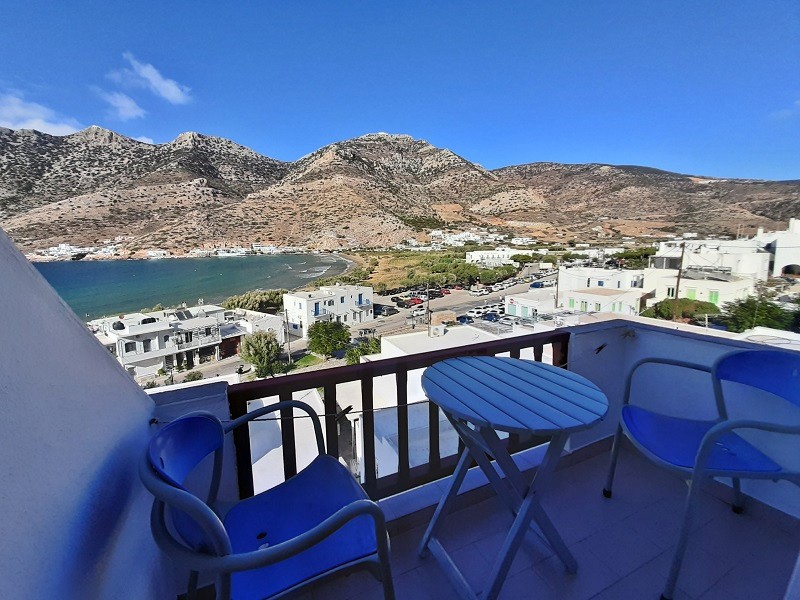
Conclusion
Sifnos may not be the best known of the Cyclades, but this beautiful Greek island offers an abundance of stunning sights and fantastic beaches.
The picturesque old town of Kastro, the charming backstreets of Apollonia, and the Mycenaean Acropolis of Agios Andreas rank among the biggest sights on Sifnos.
When it comes to beaches, you have a wide choice on the island of Sifnos, whether you prefer sandy beaches like those in Kamares, Vathi, and Platis Gialos, or enjoy jumping straight into the sea from the rocks or a swimming platform, as found around the rocky inlet of Cherronisos.
However, Sifnos is not only about its towns and beaches, as the wild natural beauty of the island is also a sight to behold.
Although we have listed the main sights and beaches of Sifnos in this travel guide, it is important to remember that there is much more to discover if you venture off the beaten path.
Trip report index
This article is part of the ‘Wonderful Greek Island Escape: My Trip to the Cyclades‘ trip report, which consists of the following chapters:
1. A Misty Morning Walk Around the Old Port of Hamburg
2. Review: EuroCity Train ‘Berliner’ Hamburg to Berlin and Prague
3. Back to Germany: From Prague to Frankfurt by Train
4. From Frankfurt to Athens: A Flight Into the Greek Sun
5. Greek Ferry Guide: How to Reach the Western Cyclades
6. Review: Speedrunner Ferry Piraeus to Serifos and Sifnos
7. Sifnos Travel Guide: Explore the Best Sights and Beaches (current chapter)
8. Kamares: The Rugged and Relaxed Port Town of Sifnos
9. The Church of Agios Symeon: The Best Sunset Spot on Sifnos
** rest of the chapters to follow soon **

